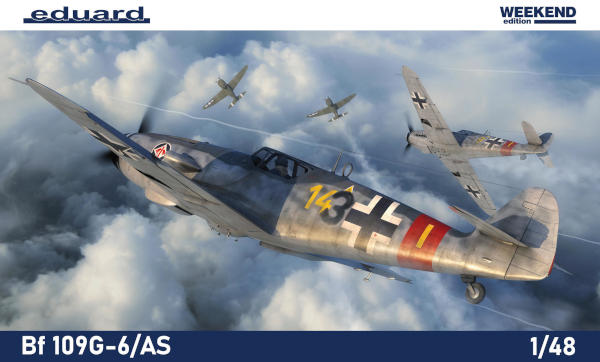
Eduard 1/48 Bf109G-6/AS
By Jacob Russell
The Messerschmitt Bf109G-6/AS was developed to intercept enemy aircraft at higher altitudes. It entered service with the Luftwaffe in April of 1944. The G-6/AS was converted from standard G-6 aircraft. Some were equipped with the MW-50 (Methanol/Wasser) system and the DB 605AM engine. Others used the FuG 16zy radio set with a Morane antenna underneath the fuselage. These planes were designated G-6/AS/AS/y and served as command aircraft. 686 aircraft were built including 226 built from scratch.
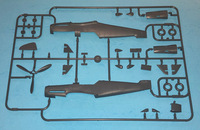
|
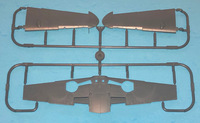
|
Eduard's new Weekend edition kit comes in their customary stout box with evocative artwork of a pair of Bf109/AS fighter engaged in battle with P-47s high over the Reich. It consists of 184 plastic parts on 5 sprues, one of which is clear.
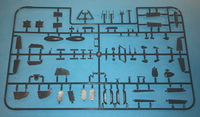
|
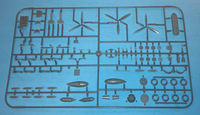
|
The surface detail on the wings and fuselage consists of recessed panel lines and rivets and this detail is superb. The wheel wells are deep, multi-piece moldings that are convincing. The leading edge slats are separate pieces. The ailerons, under wing radiator flaps and horizontal stabilizers are also individual pieces. The fabric effect on the ailerons, rudder and horizontal stabilizers is good. The landing gear are well executed.
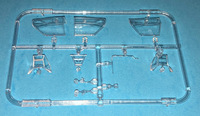
|
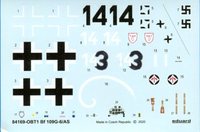
|
Optional parts include a number of Rustsatze (field conversion sets): R-1 (ETC 900/IXb rack with SC 250 bomb), R-2 (ETC 50/VIId rack with 4 SC 50 bombs), R-3 (300 liter drop tank), R-6 (MG 151/20MM under wing cannon) and R-7 (Direction Finding (DF) loop). These parts are nice to have and very useful.
The clear parts include 2 gun sights, 3 different windscreens, the fuel line, "Galland Panzer" canopy armor and 3 different Erla Haube canopies.
Eduard's decals are crisp, with bright colors and good registration. There are 3 sheets and you get 2 sets of air frame stencils. There are 5 different aircraft options:
"Yellow 14", 9./JG 1, Paderborn, Germany, May 1944. The camouflage is the standard mid War colors of RLM 74 and 75 over 76 with a moderate mottle of 74 and 75, a black spinner with a white spiral, RLM 70/white spinner backing plate and RLM 23 Red fuselage band.
"Black 14", W. Nr. 412179, Uffz. Horst Petschler, 2./JG 3, Burg near Magdeburg, Germany, May 1944. This plane was overall RLM 76 with an RLM 04 Yellow lower cowling, RLM 70/white spinner backing plate and a black spinner with a white spiral.
"Red 2", Hptm. Friedrich-Karl Müller, CO of 1./NJGr. 10, Werneuchen, Germany, July1944. The camouflage was RLM 74/75/76 with a wide RLM 23 Red fuselage band. The fuselage sides had a loose 74/75 mottle and the lower surfaces and fuselage were overpainted with black paint. The spinner was black with a white spiral and the spinner backing plate was RLM 70/white. The fin and rudder were RLM 75 with a 74 mottle and both were overpainted with RLM 76.
"Yellow 6", MT-463, ylikersanti (Staff Sergeant) Tapio Järvi, 2/HLeLv 24, Lappeenranta, Finland, March 1945. The camouflage was RLM 74/75/76 with an RLM 04 Yellow fuselage band, forward lower cowl and wing tips The fuselage sides had a loose 74/75 mottle and the spinner was RLM 70 and white and the backing plate was black.
"MT-463", HleLv 31, Utti, Finland, Summer 1948. The camouflage was RLM 74/75/76 with an RLM 74/75 mottle and the fin and rudder were Olive Green. The spinner black plate was black and the spinner was RLM 70 Green and white.
The instructions are up to Eduard's usual standards. The instructions include a parts map, a well illustrated and logical build sequence, full color profiles of all 5 decal options and a stencil application guide. Color call outs are for GSI Creos (Gunze) Aqueous, Mr. Color and Mission Models paints.

|
The G-6/AS Weekend has 5 exciting decal options and you have your pick of the various Brassin and PE sets if you want to add some detail. I recommend this kit and I would like to thank Eduard for the review sample.
References
Bf109 Late Versions, Camouflage & Markings, Krzysztof W. Woɫowski, MMP Books, 2010
